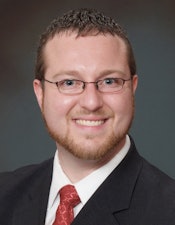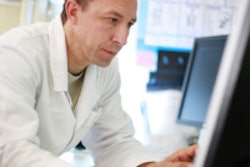
These days, radiology residents have a lot to learn and precious little time to learn it. But if they hope to survive the new healthcare reality, they'll need to pile some leadership skills on top of the technical knowledge they're committing to memory, according to one former radiology resident who's been there.
The value of leadership skills is huge. Such skills allow young radiologists to learn how to shape radiology within the larger context of the healthcare system, said Dr. Richard Sharpe, a former radiology resident at Thomas Jefferson University and a current fellow in breast imaging at Beth Israel Deaconess Medical Center.
Sharpe discussed the importance of leadership in a presentation at the RSNA 2013 meeting in Chicago.
Why leadership?
Leadership is important because healthcare's problems are so big and demand so many new solutions. The healthcare industry currently consumes a larger percentage of the U.S. gross domestic product -- nearly 18% -- than in any other industrialized country, and what patients are getting for all that money isn't always clear, Sharpe said.
 Dr. Richard Sharpe from Beth Israel Deaconess Medical Center.
Dr. Richard Sharpe from Beth Israel Deaconess Medical Center.
"The shifting healthcare paradigm demands that radiologists become leaders," he said. "We have legislators, payors, and patients all increasingly critical of healthcare expenditures, and the concern is that it's leading to overutilization, which can drive up costs even further. And we all know that [this] has the potential to expose patients to unnecessary ionizing radiation."
Yet as important as leadership skills might appear, other demands take the lion's share of the average resident's attention. The board exams focus on scientific knowledge and radiology skills rather than leadership development.
In recent years as technology has exploded, learning demands have increased. Today's radiology trainees really have more of everything to learn, Sharpe said. Also, on the clinical side, lower reimbursements can lead to greater demand for clinical services to maintain revenue, further constraining study time.
Even if they find time, young radiologists may also feel that the older, established radiologists have all the leadership roles sewn up, and there's no need for them to do anything. But they're wrong, according to Sharpe.
Defining leadership
Leadership goes beyond the traditional definition of directing activities, Sharpe said.
"Modern expectations of leadership include being trustworthy, being proficient, being an expert, being responsible, being a person who demonstrates good communication, and also being one whom others are willing to follow," he said.
In the context of radiology, young radiologists are taking on projects every day that demonstrate leadership while improving healthcare throughout the enterprise, Sharpe said.
Examples include a project at Thomas Jefferson University to focus the radiology residency curriculum more on the new American Board of Radiology (ABR) certification process. Radiology resident Dr. Chris Gutjahr surveyed trainees about potential improvements, organized and presented the data to the program director and chief residents, and worked to incorporate the improvements into the curriculum, Sharpe said.
"These have been well received by trainees," he said. "And it started because the resident saw himself as someone who had ideas that could improve the curriculum and worked with his peers to gather ideas and implement them."
As another example, Dr. Matt Hawkins focused on advocacy when he was a resident at the University of Cincinnati. He created a video that explained the trainee's role in political advocacy and encouraged residents to contribute to the RADPAC political action committee.
Meanwhile, another resident developed a project to eliminate misdirected phone calls from referring physicians in a large academic center by creating quick-reference phone lists for clinicians to contact radiologists. Misdirected calls were dramatically reduced, Sharpe said.
Residents can think of their own ideas and bring them home to their own institutions.
"One of the traits of leadership is not just having awareness that there's a problem, but the dedication, the willingness, and the strategic thought to come up with a solution to resolve the problem," he said.
Knowledge expertise
Knowledge is another way to lead for residents who are willing to open their minds to nontraditional topics that are part of the new radiology paradigm, according to Sharpe.
Mastering unique knowledge can be helpful in a variety of pursuits, ranging from management, leadership, and patient safety to healthcare quality and finance.
For example, it's tempting to think of IT as the sole domain of the technical support staff. However, radiologists are the ones who truly understand workflow and patient considerations, and they should consider IT their own responsibility, Sharpe said.
A question to consider is: "How can I help IT understand the needs of the radiologist?" The answer is in some ways our responsibility, regarding the areas in which we can make a significant contribution, he said.
Stewardship of quality care
Another interesting leadership project could begin with the Residency Review Committee's requirement regarding systems-based practice. There are many ways to pursue this requirement and a wide range of articles available on quality management and assurance. The Journal of the American College of Radiology's "Quality Matters" section has lots of good topics, according to Sharpe.
Adopt best practices by understanding American College of Radiology (ACR) Appropriateness Criteria. Discuss them with referring physicians, clarify when potentially inappropriate studies are ordered, and educate medical students, he said.
One resident, for example, focused on education in an effort to improve nonradiologist clinicians' understanding of appropriate imaging. Dr. Laryssa Hud from Thomas Jefferson University created educational presentations based on ACR Appropriateness Criteria that explained recommended imaging for common clinical conditions.
Teach, research, and create the future
Tomorrow's radiology leaders submit abstracts and write papers. They secure the dedicated time needed to lead their projects to fruition. Grants are available to fund these endeavors from sources such as the RSNA Research & Education Foundation.
Why not design a lecture for medical students and test their understanding of the material covered? Become a mentor. The best educators consider every educational activity as a publishable event, Sharpe said.
Finally, future leaders build relationships with radiology stakeholders and foster connections. Also, get to know nonradiology residents, he said, and sponsor multispecialty hospital gatherings. And through it all, foster mutual respect rather than antagonism.
But in large part being a leader involves mastering complex knowledge, starting with the basics and working up from there.
"I like to equate this to Maslow's hierarchy of needs," he said. "The concept is that before you can achieve things like friendship, security, self-esteem, creativity, and spontaneity, you first have to have some basic things steady beneath you, such as breathing, food, water, and sleep."
"Then we have safety, love, esteem; all of these are higher-order concepts that you cannot really appreciate without the ones below you in the pyramid already secured," Sharpe continued. "And at the top are leadership skills: problem-solving, acceptance of facts, creativity, and morality -- these are all essential leadership skills. So in the same way that we have to build a solid foundation in life, we also have to do that in our work."



















